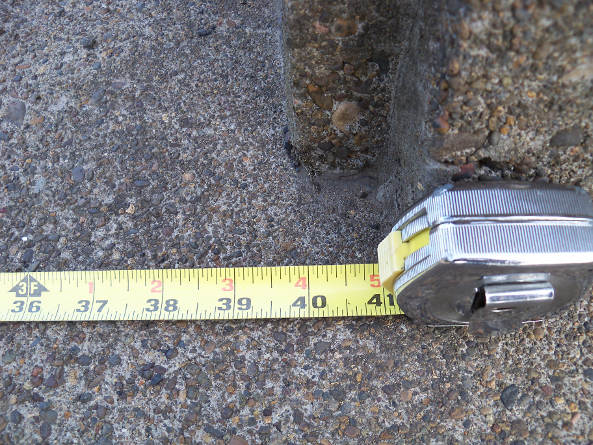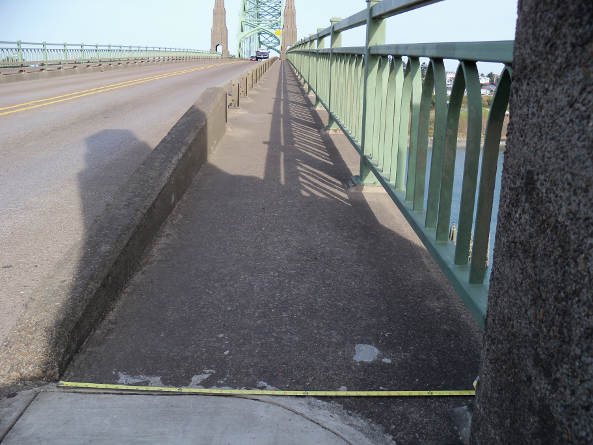The Yaquina Bay Bridge
 The Yaquina Bay Bridge in Newport, Oregon – north is to the left, south to the right.
The Yaquina Bay Bridge in Newport, Oregon – north is to the left, south to the right.
On the Pacific Coast of Oregon State, an extremely popular cycle touring route along Highway 101, there are a number of bridges bicyclists and tricyclists must cross. A couple of them are quite emotionally unsettling for many cyclists, as evidenced by numerous comments and stories found on the Crazy Guy On A Bike website (CGOAB). These notorious bridges were designed by a petroleum powered human named Conde B. McCullough, who gave precious little thought to human powered humans back in the 1930s.
The two bridges that evoke the most fear amongst some cyclists are the bridges that span Coos Bay in southern Oregon, and Yaquina Bay in northern Oregon. A sister page describing an easy work-around for the Coos Bay bridge can be found HERE if you are going to ride this route. That bridge can be entirely circumvented on an easy road, although, it can also be ridden safely with a fully loaded tricycle on the sidewalk, which is 40 inches wide.
To view this article on the Crazy Guy On A Bike website, click HERE.
 North to the left – the longest span of Yaquina Bay Bridge is south of the apex.
North to the left – the longest span of Yaquina Bay Bridge is south of the apex.
The Yaquina Bay Bridge, in Newport, Oregon, has absolutely no work-around bypass solution like the Coos Bay Bridge has. To bypass the Yaquina Bay Bridge would require riding inland for two extra days and many long miles through mountains, so cyclists pretty much MUST ride over this bridge. But, fear not, those of you who have yet to meet this supposed nemesis of the cycling world! I enjoy debunking cycling mythology, and will now present to you facts that completely remove any fear whatsoever!
As with the Coos Bay Bridge at North Bend, Oregon, the sidewalk is 40 inches wide, which is ample for riding a fully loaded touring trike out of the automobile traffic lane. Unlike the Coos Bay Bridge however, this Yaquina Bay Bridge at Newport has jogs in the sidewalk where you notice those concrete pillars sticking up for design aesthetics. Even these obstacles are not really obstacles however, as the clearance is more than enough to ride a touring trike through without hitting.
 Looking north towards Washington. Notice the little jogs at the pillars.
Looking north towards Washington. Notice the little jogs at the pillars.
 There is a button you can push to activate flashing lights that warn motorists. Speed limit is 35 MPH.
There is a button you can push to activate flashing lights that warn motorists. Speed limit is 35 MPH.
 Tricyclists can simply pedal over the sidewalk. It appears narrow, but is not, as you shall see below.
Tricyclists can simply pedal over the sidewalk. It appears narrow, but is not, as you shall see below.
 Here is my trusty tape measure, showing 40 inches of triking joy, even with loaded panniers!
Here is my trusty tape measure, showing 40 inches of triking joy, even with loaded panniers!
 Yep, just like the Coos Bay Bridge, forty is the magic number.
Yep, just like the Coos Bay Bridge, forty is the magic number.
 Farther up the span, this change appears, but is still rideable by loaded trikes.
Farther up the span, this change appears, but is still rideable by loaded trikes.
 The 37 inch mark is at a slight jog, and there is plenty of room in this little section.
The 37 inch mark is at a slight jog, and there is plenty of room in this little section.
 Here is one of the concrete jogs, which is even wider than the normal sidewalk!
Here is one of the concrete jogs, which is even wider than the normal sidewalk!
 You have an extra two inches through the concrete archway. This is easy!
You have an extra two inches through the concrete archway. This is easy!
 The view from inside the short archway, 133 feet above the water below, is grand.
The view from inside the short archway, 133 feet above the water below, is grand.
 Emerging from the archway puts you back in the wind. Good thing you are low on a trike!
Emerging from the archway puts you back in the wind. Good thing you are low on a trike!
 This is looking eastward, into Yaquina Bay, with Old Towne along the shoreline. By the way, Yaquina is pronounced as it appears (Ya-Kwin-A).
This is looking eastward, into Yaquina Bay, with Old Towne along the shoreline. By the way, Yaquina is pronounced as it appears (Ya-Kwin-A).
 This is the view of the Pacific Ocean from near the apex of Yaquina Bay Bridge – can be windy.
This is the view of the Pacific Ocean from near the apex of Yaquina Bay Bridge – can be windy.
 A telephoto view going over the apex shows the unobstructed pathway over this easy bridge crossing.
A telephoto view going over the apex shows the unobstructed pathway over this easy bridge crossing.
Most of the 10,000 cyclists who ride the Oregon Coast ride from north to south, placing them on the ocean side of the highway, and also riding with the predominantly northwest summer winds. If riding north to south, you could ride the automobile roadway, because the span to the apex in this direction is short and not very steep, which then allows you to coast easily at 35 miles per hour down the southern side of the bridge (speed limit for cars). If you are riding this bridge from south to north, I definitely recommend using this sidewalk solution, because it is a long haul to the apex, and it is also fairly steep – you would be in traffic for a long time (which unnerves some cyclists).
 Short span to the north – long span to the south – shipping lane under arched apex
Short span to the north – long span to the south – shipping lane under arched apex
* * * * * * *

You must be logged in to post a comment.